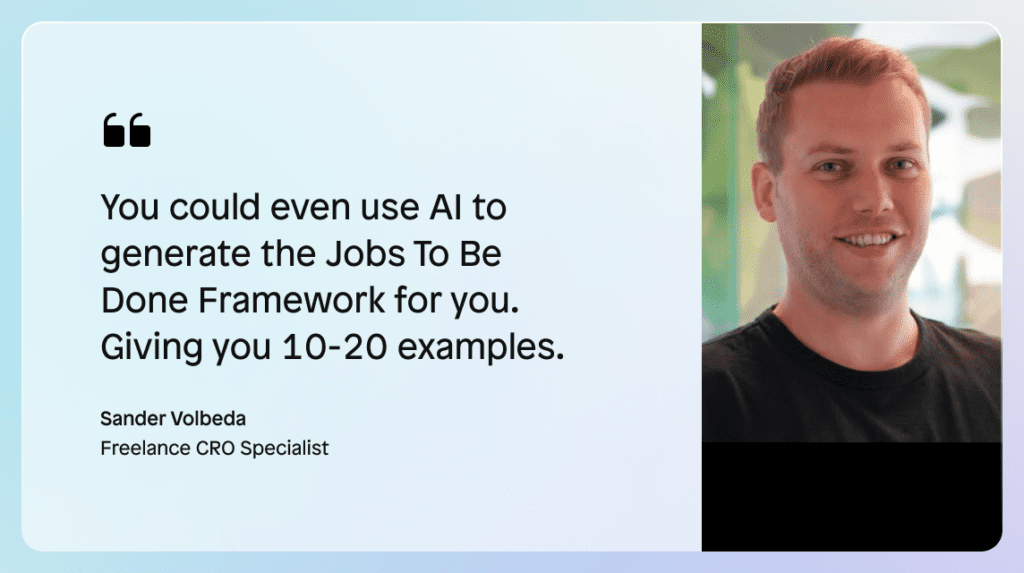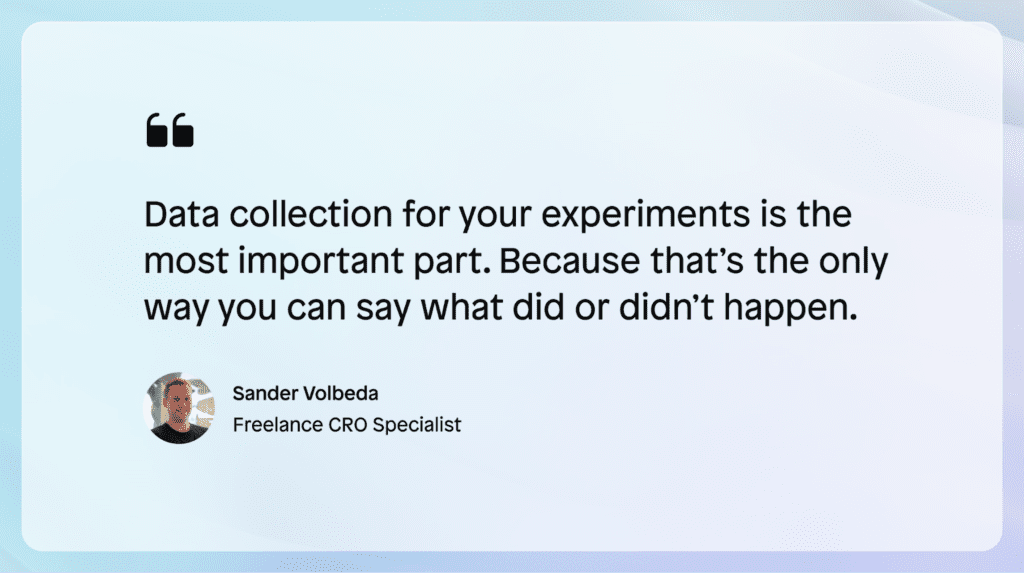One easy way to approach conversion rate optimization for those just getting started is by using an experimentation framework. Recently, Sander discussed all this and more as a guest on Instant’s “Click to Buy” podcast.
This article recaps the highlights from the episode, including Sander’s advice on how to implement three popular experimentation frameworks.
This guest blog was written by Rebecca Anderson, the Host of Click to Buy (a conversion-focused podcast) and the Content Marketing Manager at Instant Landing Page Builder – the no-code Shopify page builder.
There are no shortcuts when it comes to conversion optimization, but there are tools and ways of thinking that can help eCommerce businesses to approach their CRO strategy. To create a structured approach to conversion optimization, Sander recommended three experimentation frameworks:
Here’s how Sander broke down these three frameworks for the Click to Buy audience:
Here’s the easiest way to understand the JTBD framework: every visitor to a website has a distinct “job” they aim to complete, a trigger that moves them to action, and an outcome they hope to achieve.
The job is whatever they are trying to accomplish on your site, like wanting to buy some new clothes.
At some point, they get triggered to take action and try to accomplish this goal. Like they may want to update their wardrobe for the Fall.
Their desired outcome is the successful purchase of new, Fall-ready clothes.
By identifying these jobs, triggers, and outcomes, you can tailor the user experience of your eCommerce site to meet the needs of your visitors better.
This is important because each type of visitor may have a different job in mind.
For example, let’s take a shopper who’s looking for trendy, fast-fashion pieces versus a shopper who’s looking to add a longer-term fashion piece to their wardrobe.
Fast-fashion shoppers might prioritize looking at product imagery and customer reviews because they care about what a product looks like/if it’s on trend.
A shopper who is looking for a long-term staple to add to their wardrobe likely has different priorities.
They might dive into product descriptions on your site because they want to understand the quality and longevity of the product.
Because they have different “jobs” in mind, their experience on your site will likely differ.
So, accounting for the different types of visitors that will check out your online shop is important to identifying these different jobs.

As a bonus tip – Sander recommends using ChatGPT to help you generate ideas for the JTBD framework.
The PAS framework is a particularly effective strategy for landing page conversion optimization.
To understand how this works, Sander described selling vegan leather bags.
The problem is the need for more stylish, affordable vegan leather bags available to purchase.
The agitation is focused on emphasizing their lack of availability and high prices.
The solution to this problem is a chic, reasonably priced vegan leather bag.
With this framework, you’ve positioned your product (the vegan leather bag) as the answer to your prospective customer’s needs (a cost-friendly, stylish solution!).
A/B testing on your online store is a method of experimentation that tests two variants to see which performs the best.
However, Sander warns that many people say “A/B testing” when they might mean experimentation.
While A/B testing is a commonly used term, it’s essential to remember that experimentation encompasses a broader spectrum.
A/B testing is just one methodology within the larger umbrella of experimentation.
To set up A/B tests, you should keep these four things top of mind:
Solid data should back every test or experiment to increase the chances of its success.
Blindly jumping into A/B testing without relevant insights can lead to inconclusive or even misleading results.
Utilizing tools such as heat maps, session recordings, and analytics platforms like Google Analytics can provide valuable insights into user behavior and preferences.
After gathering data, the next step is to construct a well-informed hypothesis.
You should include your expected outcomes with this hypothesis, and what you hope to learn.
This way, you can guide the experiment and provide a framework for evaluating your final results.
Sander cannot stress enough the significance of accurate data collection during the running of an experiment.

Incomplete or flawed date can compromise the results of experiment. Or lead you to draw incorrect conclusions.
Since your ultimate goal is to create actionable insights, flawed data can hinder the impact of your experiment.
It can feel discouraging when an experiment doesn’t yield the results you had hoped for.
But, regardless of whether an experiment has positive or negative results, there’s always an opportunity to learn.
Validating hypotheses, understanding unexpected outcomes, or identifying areas for further testing can provide a roadmap for continuous improvement.
Put more simply, knowing what doesn’t work when it comes to your online store, is just as important as knowing what does work.
In conclusion, during this podcast episode, Sander revealed three helpful frameworks that can be used for conversion rate optimization: JTBD, PAS, and A/B testing. By creating a structured, data-driven approach to experimentation, you can make meaningful changes to your site that will positively impact your customer experience. Helping customers to achieve their desired outcomes on your site is the true goal you need to focus on, not just increasing your click rate.

Working remotely from Groningen, the Netherlands. Get in touch and let’s schedule a meeting, no strings attached.
Get in touch